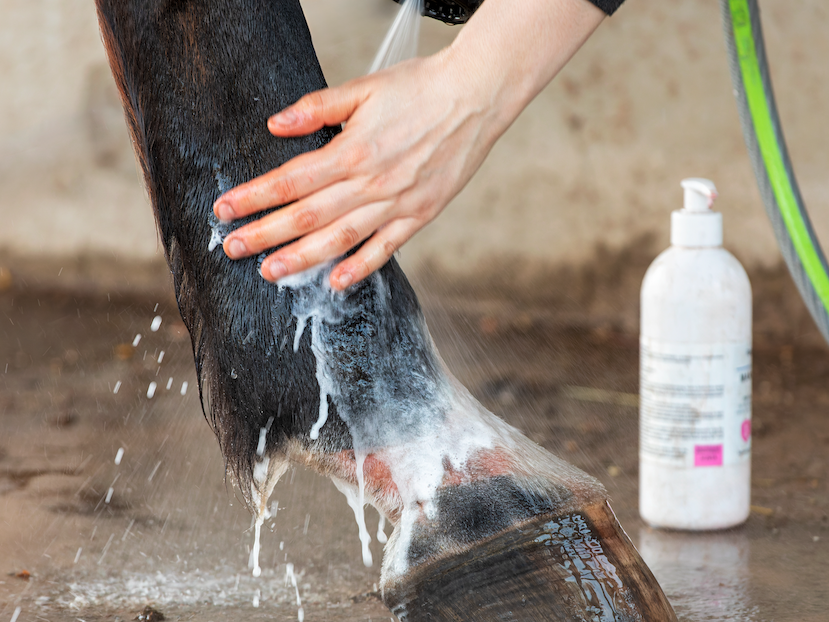It’s September, the fields are already soggy, and the Brew Room chat has (predictably) turned to mud fever. Nobody wants scabby heels and sore ponies before winter even sets in. Prevention really is better than cure - because once you’re soaking, scrubbing, and picking scabs, it’s no fun for you or your horse.
👉 Stock up on essentials in our Mud Busters Collection so you’re prepared before mud fever appears.
What is Mud Fever?
Mud fever (also known as pastern dermatitis or greasy heel) is a skin condition caused when bacteria get into softened or damaged skin, usually around the pasterns and heels. Constant wet and muddy conditions make it easy for infection to set in, leading to scabs, sores, and even lameness in severe cases.
For more background, the British Horse Society has helpful guidance on recognising and managing common equine skin conditions.
💡 Prevention essentials: Barrier Creams & Sprays | Pig Oil & Sulphur | Horse Supplements Collection
How Do You Spot Mud Fever Early?
Look out for:
-
Scabs or crusts on the pastern and heel
-
Redness or heat
-
Bald patches or matted hair
-
Swelling or sensitivity when touched
Catching it early makes it much easier to manage. A quick daily check while picking out feet or grooming can save weeks of hassle later.
Image Credit: Brown Moss Equine Clinic
👉 Browse our Horse Grooming Collection for brushes, wipes, and washes that make daily leg checks easy.
How Do You Prevent Mud Fever in Horses?
This is where we all agreed in the Brew Room: prevention beats cure every time.
-
Keep legs dry → Bring horses in off wet fields for part of the day, and keep bedding fresh.
💡 Find stable essentials in our Yard & Bedding Collection -
Wash wisely → Over-washing softens skin. Let mud dry and brush it off, or use wipes instead of the hose.
💡 Try Aqueos Antibacterial Horse Wipes from our Horse First Aid Collection
📖 For more advice, National Veterinary Services has a great section on horse health and management -
Barrier protection → Use barrier creams, sprays, or pig oil & sulphur to stop mud sticking. Pig oil & sulphur is a traditional go-to on many yards — it waterproofs, conditions, and works especially well on feathered legs.
💡 Shop Pig Oil & Sulphur and Barrier Creams in our Horse First Aid & Skincare Collection -
Manage feathers → Trimming feathers makes cleaning easier and ensures barrier products can reach the skin.
💡 Tidy up with tools from our Horse Clippers & Trimmers Collection -
Boost skin health from within → Supplements containing zinc, biotin, and omega oils help strengthen skin.
💡 Explore our Horse Supplements Collection for coat and skin health.
Should You Wash Your Horse’s Legs Every Day?
Not unless you have to. Daily hosing softens the skin, making it more vulnerable to infection. It’s better to:
-
Let mud dry and brush it off
-
Wipe legs clean if needed
-
Save washes for thick, stubborn mud
👉 Keep a pack of Antibacterial Horse Wipes in your grooming kit — they’re quicker, easier, and far kinder to the skin.
Can Pig Oil & Sulphur Help Prevent Mud Fever?
Yes — many owners swear by it. Pig oil creates a waterproof barrier, while sulphur has antibacterial properties. Together, they help stop mud clinging and keep the skin healthier. Apply to clean, dry legs before turnout.
💡 Shop Pig Oil & Sulphur in our Horse First Aid Collection
What Is the Best Treatment for Mud Fever?
If mud fever does appear:
-
Gently clean with an antibacterial wash or wipes
-
Apply a soothing cream to protect the area
-
Don’t pick scabs harshly — let them soften and lift naturally
-
Call your vet if there’s heat, swelling, or lameness
For detailed veterinary guidance, see Liphook Equine Hospital or always speak to your own vet.
Is Mud Fever Contagious Between Horses?
Not directly. It isn’t “caught” from horse to horse, but the bacteria that cause mud fever thrive in wet, muddy environments. If several horses are standing in the same conditions, they may all be at risk.
Quick Tips to Prevent Mud Fever
-
Check legs daily
-
Avoid over-washing
-
Keep stables clean and dry
-
Use Barrier Creams, sprays, or Pig Oil & Sulphur before turnout
-
Trim feathers with Horse Clippers & Trimmers for easier care
Final Thoughts
Mud fever is one of those autumn headaches we’d all rather avoid, but with daily checks, smart management, and the right products, you can stay ahead of it. Keep legs dry, protect with barriers like pig oil & sulphur, and support healthy skin from the inside.
👉 Shop our full Mud Buster Collection and Horse Supplements Collection to get set for autumn - these are the products we keep in our own yard kits to prevent mud fever before it takes hold.
For more welfare advice, you can also visit World Horse Welfare who provide excellent resources for horse owners.






0 comments